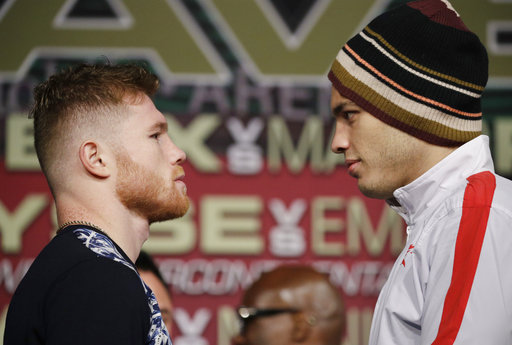Political climate adds intensity to Mexican boxing showdown

Canelo Alvarez, left, and Julio Cesar Chavez Jr. pose for photographers during a news conference in Las Vegas. The two are scheduled to fight in a 164.5 pound catch weight boxing match. AP
LAS VEGAS — There’s little subtlety in the TV commercial promoting the fight between Saul “Canelo” Alvarez and Julio Cesar Chavez Jr. on Saturday (Sunday Manila time).
The boxers are depicted to be in their native Mexico when they begin running and kicking up desert sand before bursting through a border wall and ending up on the Las Vegas Strip.
Article continues after this advertisementThere’s no shying away from the political overtones ahead of the sold-out fight that’s billed as one of the biggest involving Mexican boxers.
“In Mexico, this could be important because this could be the making of an idol who everybody could follow,” Chavez said through an interpreter. “And here in the United States, it’s also important because of what people are going through politically in this country right now with the Mexican people. This is significant.”
As President Donald Trump continues to say he will fulfill his campaign promise to build a wall along the U.S.-Mexico border, this showdown on the Cinco de Mayo holiday weekend has become more than just about 12 rounds in the ring.
Article continues after this advertisement“The thing about this wall is to show the people that we need to be united,” Alvarez said through an interpreter. “United for every cause, supporting each other for every cause. That is the message.”
The advertising campaign has caught the attention of the Latino community in Las Vegas. Justin Molina was wandering around the MGM Grand Arena with his Spanish-speaking father Thursday when he quickly nodded after being asked if he had seen the ad for the HBO pay-per-view bout.
“It’s interesting,” Molina said, adding he liked the statement it made. “We were surprised.”
The matchup of the son of Mexican great Julio Cesar Chavez Sr. and Alvarez, managed by his former rival Oscar De La Hoya, has captivated Mexico and Las Vegas. The fight at T-Mobile Arena sold out in nine days. Numerous closed circuit venues along the Strip have been added where you’ll need to pay $75 to watch. The home pay-per-view price in the U.S. is $59.95.
Two Mexican TV networks will televise Saturday’s fight. The media center at the MGM Grand casino was bustling with live Spanish television and radio shows Thursday. De La Hoya has said there were 700 requests for media credentials, although workers in the credential office declined to confirm that number Thursday.
“If you look around, there are people from all over the world coming to this fight,” said Terry Cortez, whose Los Angeles-based “El Terrible” syndicated radio show is broadcasting from Las Vegas this week. “Hispanics contribute to the economy. If (Trump) doesn’t want to see it, I think he needs to take economy classes.
“This is the perfect timing for this fight,” Cortez added, “and I think it delivers a message to the president of the United States.”
The strained relationship between Trump and Mexico is impossible to ignore this week. That the fight is one of the biggest in the boxing-loving country and coming on a holiday weekend adds to the stakes.
“(Running through) the wall is like the attitude it takes, it doesn’t matter what’s in front of you,” said Chavez, who must get down to a catchweight of 164 1/2 pounds before Friday’s weigh-in. “You have to keep going forward. But especially right now, it represents the reality that we are living. The reality to the Mexican and Latin American people, to show them that there are no limits.”
Chavez (50-2-1, 32 KOs) is eager to turn around a career marked by criticism over his commitment.
For Alvarez (48-1-1, 34 KOs), a win could lead to a long-awaited showdown with Gennady Golovkin to unify the middleweight title.
“I think it’s great for us Mexicans,” Alvarez said. “It’s a great opportunity for all the people out there to show what we’re capable of doing and what we’re made of.”